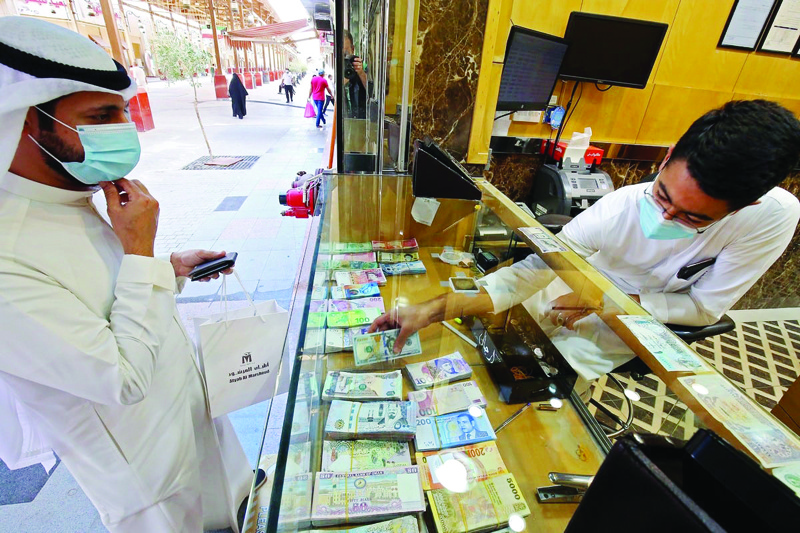 KUWAIT: A citizen checks the forex rates at a currency exchange shop in Kuwait City in this file photo. - Photo by Yasser Al-Zayyat
KUWAIT: A citizen checks the forex rates at a currency exchange shop in Kuwait City in this file photo. - Photo by Yasser Al-ZayyatKUWAIT: Domestic credit growth picked up to 2.1 percent q/q in 3Q2021 with the y/y increase at 4 percent through September. For the fifth consecutive quarter, household lending was the main growth driver, while business lending has been slow to recover from the pandemic-related slowdown. Business credit was flat in 3Q2021 with the y/y increase at only 0.3 percent through September. While the pandemic-induced shock continues to put pressure on the growth in business credit, we think that relatively high repayments/write-offs are also a likely factor for the weak business credit trends over the past year.
Nevertheless, the various sectors showed wide differences with the trade and construction sectors continuing to be the weakest, falling by 13 percent and 11 percent y/y, respectively. In contrast, credit growth in the oil/gas (+14 percent y/y) and industry (+11 percent) sectors was very robust. Credit to real estate, by far the largest component of business credit with a 43 percent share, continued to gradually inch up with the y/y increase at 2.3 percent through September.
Household credit accelerated to register the fastest quarterly growth since the third quarter of last year, with the y/y increase at 11.2 percent through September. This strong expansion was driven by housing loans as well as personal consumption loans with both growing at around 11 percent y/y. The six-month deferral of household credit installments for Kuwaiti borrowers (which is set to expire in Q4), the ongoing robust demand/high valuations in the residential real estate sector, and the continued solid consumer spending are some of the key factors behind this multi-year record expansion in household lending.
Overall credit growth in 3Q2021 got a boost from a solid expansion in lending to non-bank financial institutions, which soared by a multi-year high of nearly 10 percent q/q, and from credit for securities purchase, which increased by the second-highest quarterly rate in the past two years. Going into 2022, credit growth will likely be supported by the further normalization of economic activities given the major pickup in vaccination rates and the ongoing easing of pandemic-related restrictions.
Business credit should be supported by a likely improvement in project awards and by the pent-up demand for capital spending (CAPEX) given muted CAPEX by corporates since the outbreak of the pandemic. As for household credit, growth will likely start to trend down to pre-pandemic levels following the Q4 expiry of the six-month deferral of household credit installments of Kuwaiti borrowers.
On the other hand, passage of the mortgage law in one form or another (which is expected) will be a game changer, providing significant growth potential for the banks given the very strong demand for housing loans. Finally, in an effort to continue supporting the economic recovery, the Central Bank of Kuwait will only gradually unwind the easing of some of its liquidity and capitalization regulations that took effect in April last year due to the onset of the pandemic. Almost all prudential regulations shall get back to their pre-pandemic levels effective January 2023.
Private-sector deposits
Domestic deposits inched up by 0.8 percent q/q, fully driven by government deposits, with the y/y expansion still very much muted (-3.3 percent through September). Private-sector deposits are down 2.8 percent y/y, while government deposits have dropped by 5.5 percent probably related to the liquidity constraints that the government has been facing. However, following two quarters of steep decreases, government deposits showed improving trends, rebounding by 7.3 percent q/q likely driven by surging oil prices.
Looking at the breakdown of KD private sector deposits, the trend that has been at play since the outbreak of the pandemic (which is current and saving (CASA) deposits expanding much faster than time deposits for six consecutive quarters) reached a stand-still in 3Q2021 as CASA edged down slightly while time deposits inched up by 1 percent. Nevertheless, from a y/y perspective, CASA is still up 5.6 percent, while time deposits are down 10 percent.
The steep fall in interest rates last year (banks shedding expensive institutional deposits to defend margins and depositors facing lower opportunity cost from keeping funds in CASA deposits) and the deferral of credit instalments have been two key drivers for the changing composition of private sector deposits. The lack of growth in domestic deposits over the past year led to an increase in the sector's domestic loans-to-deposits ratio, which reached 93.5 percent in September from around 87 percent one year ago, reflecting the slightly tighter liquidity situation.
Policy interest rates on hold
The CBK's discount rate has remained at 1.5 percent since March 2020 and will likely stay at that level in the short term given that the US Federal Reserve is unlikely to hike its policy rate in the first half of 2022. However, interest rates (weighted average as calculated by the CBK) on KD-denominated deposits seem to have bottomed out and actually have started to very gradually trend higher in the past few months. Kuwaiti banks' results confirm this trend as all witnessed a q/q increase in the cost of funds in 3Q2021.










